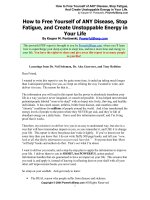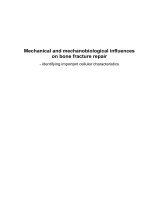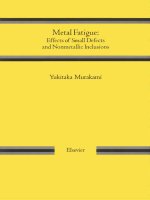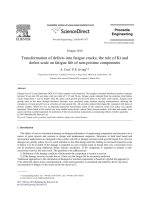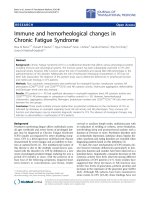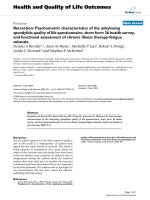Biaxial multiaxial fatigue and fracture
Bạn đang xem bản rút gọn của tài liệu. Xem và tải ngay bản đầy đủ của tài liệu tại đây (14.08 MB, 522 trang )
Biaxial1
Fracture
1-
BIAXIAL/MULTIAXIAL FATIGUE AND FRACTURE
I
R 45
M
Other titles in the ESlS Series
EGF 1
EGF 2
EGF 3
EGF 4
EGF 5
EGF 6
EGF 7
EGFIESIS 8
ESIS/EGF 9
ESlS I O
ESIS I I
ESlS 12
ESlS 13
ESlS 14
ESlS 15
ESIS 16
ESlS 17
ESIS 18
ESIS 19
ESlS 20
ESlS 21
ESIS 22
ESlS 23
ESlS 24
ESlS 25
ESIS 26
ESIS 27
ESIS 28
ESIS 29
ESlS 30
The Behaviour of Short Fatigue Cracks
Edited by K.J. Miller and E.R. de 10s Rios
The Fmcture Mechanics of Welds
Edited by J.G. Blauel and K.-H. Schwalbe
Biaxial and Multiaxial Fatigue
Edited by M.W. Brown and K.J. Miller
The Assessment ofCracked Components h-v Fracture Mechanics
Edited by L.H. Larsson
Yielding, Damage, and Failure OfAnisotmpic So1id.s
Edited by J.F! Boehler
High Temperature Fracture Mechanisms and Mechanics
Edited by P. Bensussan and J.P. Mascarell
Environment Assisted Fatigue
Edited by P Scott and R.A. Cottis
Fracture Mechanics Verification by Large Scale Testing
Edited by K . Kussmaul
Dcfect Assessment in Components Fundamentals and Applications
Edited by J.G. Blauel and K.-H. Schwalbe
Fatigue under Biaxial and Multiaxial Loading
Edited by K. Kussmaul, D.L. McDiarmid and D.F. Socie
Mechanics and Mechanisms of’ Damage in Composites and Multi-Materials
Edited by D. Baptiste
High Temperature Structural Design
Edited by L.H. Larsson
Short Fatigue Cracks
Edited by K.J. Miller and E.R. de 10s Rios
Mixed-Mode Fatigue and Fracture
Edited by H.P. Rossmanith and K.J. Miller
Behaviour of Defect.s at High Rmpemtures
Edited by R.A. Ainsworth and R.P. Skelton
Fatigue Design
Edited by J. Solin, G. Marquis, A. Siljander and S. Sipila
Mis-Matching of Welds
Edited by K.-H. Schwalbe and M. KoCak
Fretting Fatigue
Edited by R.B. Waterhouse and T.C. Lindley
Impnct of Dynamic Fracture of Polymers and Composites
Edited by J.G. Williams and A. Pavan
Evaluating Material Properties by Dynamic Testing
Edited by E. van Walle
Multiaxial Fatigue & Design
Edited by A. Pineau, G. Gailletaud and T.C. Lindley
Fatigue Design of Components. ISBN 008-0433 18-9
Edited by G. Marquis and J. Solin
Futigue Design and Reliability. ISBN 008-043329-4
Edited by G. Marquis and J. Solin
Minimum Reinforcement in Concrete Member.s. ISBN 008-043022-8
Edited by Albert0 Carpinteri
Multiaxial Fatigue and Fracture. lSBN 008-043336-7
Edited by E. Macha, W. Bqdkowski and T. aagoda
Fracture Mechanics: Applications and Challenges. ISBN 008-043699-4
Edited by M. Fuentes, M. Elices, A. Martin-Meizoso and J.M. Martinez-Esnaola
Fracture of Po[vmer.s, Composites andddhesives. ISBN 008-0437 10-9
Edited by J.G. Williams and A. Pavan
Fracture Mechanics Testing Method.s,fiirPo1ymer.s Adhesives and Comjmsites.
ISBN 008-043689-7
Edited by D.R. Moore, A. Pavan and J.G. Williams
Temperature-Fatigue Inteemction.
ISBN 008-043982-9
Edited by L. Remy and J. Petit
From Charp.v to Present Impuct Te.sting.
ISBN 008-043970-5
Edited by D. FranCois and A. Pineau
For information on how to order titles 1-21, please contact MEP Ltd Northgate Avenue.
Bury St Edmonds, Suffolk, IP32 6BW, UK. Titles 22-29 can be ordered from Elsevier
().
BIAXIALMULTIAXIAL FATIGUE AND FRACTURE
Editors:
Andrea Carpinteri
Manuel de Freitas
Andrea Spagnoli
ESIS Publication 31
This volume contains 25 peer-reviewed papers selected from those presented
at the 6thInternational Conference on BiaxialMultiaxial Fatigue and Fracture
held in Lisbon, Portugal, 25-28 June 2001.
The meeting was organised by the Instituto Superior Tecnico and sponsored by the
Portuguese Ministerio da Ciencia e da Tecnologia and by the
European Structural Integrity Society.
x SIS
2003
Elsevier
Amsterdam - Boston - London - New York - Oxford - Paris
San Diego - San Francisco - Singapore - Sydney - Tokyo
ELSEVIER SCIENCE Ltd.
The Boulevard Langford Lane
Kidlington, Oxford OX5 IGB, UK
0 2003 Elsevier Science Ltd. And ESIS. All rights reserved.
This work is protected under copyright by Elsevier Science, and the following terms and conditions apply to its use:
Photocopying
Single photocopies of single chapters may be made for personal use as allowed by national copyright laws. Permission of the
Publisher and payment of a fee i s required for all other photocopying, including multiple or systematic copying, copying for
advertising or promotional purposes, resale, and all forms of document delivery. Special rates are available for educational institutions that wish to make photocopies for non-profit educational classroom use.
Permissions may be sought directly from Elsevier’s Science & Technology Rights Department in Oxford, U K phone: (+44) 1865
843830, fax: (+44) I865 853333, e-mail: may also complete your request on-line via the Elsevier
Science homepage (http:Nwww.elsevier.com), by selecting ‘Customer Support’ and then ‘Obtaining Permissions’.
In the USA, users may clear permissions and make payments through the Copyright Clearance Center, Inc., 222 Rosewood Drive,
Danvers, MA 01923, USA; phone: ( + I ) (978) 7508400, fax: ( + I ) (978) 7504744, and in the UK through the Copyright Licensing
Agency Rapid Clearance Service (CLARCS), 90 Tottenham Court Road, London W I P OLP, UK; phone: (+44) 207 631 5555; fax:
(+44) 207 63 1 5500. Other countries may have a local reprographic rights agency for payments.
Derivative Works
Tables of contents r a y be reproduced for internal circulation, but permission of Elsevier Science is required for external resale
or distribution of such material.
Permission of the PLI,I rher is required for all other derivative works, including compilations and nanslations.
Electronic Storage or Usage
Permission of the Publisher is required to store or use electronically any material contained in this work, including any chapter
or part of a chapter.
Except as outlined above, no part of this work m2-r be reproduced stored in a retrieval system or transmitted in any form
or by any means, electronic, mechanical, photocopyi , recording or otherwise, without prior written permission of the Publisher.
Address permissions requests to: Elsevier’s Science & lechnology Rights Department, at the phone, fax and e-mail addresses noted
above.
Notice
No responsibility is assumed by the Publisher for any injury and/or damage to persons or property as a matter of products
liability, negligence or otherwise, or from any use or operation of any methods, products, instructions or ideas contained in the
material herein. Because of rapid advances in the medical sciences, in particular, independent verification of diagnoses and
drug dosages should be made.
First edition 2003
Library of Congress Cataloging in Publication Data
A catalog record from the Library of Congress has been applied for.
British Library Cataloguing in Publication Data
A catalogue record from the British Library has been applied for.
ISBN : 0-08-044129-7
ISSN : 1566-1369
@ The paper used in this publication meets the requirements ofANSI/NISO 239.48-1992 (Permanence of Paper).
Printed in The Netherlands.
The papers presented in these proceedings have been reproduced directly from the authors’ ’camera ready’ manuscripts. As
such, the presentation and reproduction quality may vary from paper to paper.
V
CONFERENCE COMMITTEES
International Scientific Committee:
P. Bonacuse (USA)
M.W.Brown (UK)
A. Carpinteri (Italy)
K. Dang Van (France)
F. Ellyin (Canada)
U. Fernando (UK)
D. Franqois (France)
M. de Freitas (Portugal)
Chairman
G. Glinka (Canada)
S. Kalluri (USA)
E. Macha (Poland)
G. Marquis (Finland)
D.L. McDowell (USA)
K.J. Miller (UK)
Y. Murakami (Japan)
J. Petit (France)
A. Pineau (France)
L. Pook (UK)
V. Shlyannikov (Russia)
D. Socie (USA)
C. Sonsino (Germany)
S. Stanzl-Tschegg (Austria)
T. Topper (Canada)
V. Troschenko (Uhaine)
E. Tschegg (Austria)
S. Zamrik (USA)
H. Zenner (Germany)
Organizing Committee:
M. de Freitas (Chairman), M. Fonte, B. Li
-
EIsevier Internet Homepage http:/hPww.elsevier.com
Consult the Elsevier homepage for full catalogue information on all books. journals and electronic products and services.
Elsevier Titles of Related Interest
CARPINTERI
Minimum Reinforcement in Concrete Members.
ISBN: W8-043022-8
MURAKAMI
Metal Fatigue Effects of Small Defects and Nonmetallic
Inclusions
ISBN: W8-044064-9
FRANPIS and PINEAU
From Charpy to prescot Impact Testing.
ISBN. 008043970-5
RAVICHANDRAN ETAL
Small Fatigue Crack Mechpnics. Mechanisms C Applicatims.
ISBN: 008443011-2
NENTES ETAL.
Fracture Mechanics: Applicationsand Challenges.
ReMY and PmlT
ISBN 008-043699-4
Temperature-FatigueInteraction.
ISBN: 008-043982-9
JONES
Failure Analysis Care Studies 11.
ISBN. WR-043959-4
TANAKA C DULIKRAVICH
Inverse Problems in Engineering Mechanics 11.
ISBN: W8-043693-5
MACHA €TAL
Muluaxial Fatigue and Fracture.
ISBN: 008-043336-7
UOMOTO
Non-DestructiveTesting in Civil Engineaing
ISBN: w8-0437174
MARQUIS C SOLIN
Fatigue Design of Components.
VOYlADJISETAL
Damage Mechanics in hgineering Materials
ISBN: 008-043318-9
ISBN: 008-043322-7
MARQUIS & SOLIN
Fatigue Design and Reliability.
VOYIADJIS & KATTAN
Advances in Damage Mechanics:Metals and Metal Matrix
Composites.
ISBN: 008-043329-4
ISBN. W8-043601.3
MOORE E T A L
Fracture Mechanics Testing Methods for Polymers. Adhesives
and Composites.
ISBN: 008043689-7
WILLIAMS & PAVAN
Fracture of Polymers,Compositesand Adhesives.
ISBN: 008-043710-9
Related Journals
Free specimen copy gladly sent on request. Elsevier Ltd, The Boulevard, Langford Lane. Kidlington, Oxford,
OX5 IGB, UK
Acta Metallurgicaet Materialia
Cement and Concrete Research
Composite Structures
Computers and Structures
Corrosion Science
Engineering Failure Analysis
Engineering Fracture Mechanics
European Journal of Mechanics A & B
InternationalJournal of Fatigue
InternationalJournal of Impact Engineering
InternationalJournal of Mechanical Sciences
InternationalJournal of Non-Linear Mechanii:S
InternationalJournal of Plasticity
International Journal of Pressure Vessels & Piping
InternationalJoumal of Solids and Structures
Journal of Applied Mathematicsand Mechanics
Joumal of Construction Steel Research
Journal of the Mechanics and Physics of Solids
Materials Research Bulletin
Mechanics of Materials
Mechanics Research Communications
NDTBrE International
Scripta Metallurgicaet Materialia
Theoretical and Applied Fracture Mechanics
Tribology International
Wear
To Contact the Publisher
Elsevier Science welcomes enquiries concerning publishing proposals: books, journal special issues, conference
proceedings, etc. All formats and media can be considered. Should you have a publishing proposal you wish to discuss,
please contact, without obligation, the publisher responsible for Elsevier's mechanics and structural integrity publishing
pmpmme:
Dean Eastbury
Senior Publishing Editor, Materials Science &Engineering
Elsevier Ltd
Phone:
The Boulevard, Langford Lane
Kidlington, Oxford
Fax:
OX5 IGB, UK
E.mail:
+44 1865 843580
+44 1865 843920
General enquiries, including placing orders, should be directed to Elsevier's Regional Sales Offices -please access the
Elsevier homepage for full contact details (homepage details at the top of this page).
vii
CONTENTS
Preface
xi
1. Multiaxial Fatigue of Welded Structures
Assessment of Welded Structures by a Structural Multiaxial Fatigue Approach
K. Dung Van,A. Bignonnet and J. L. Fayard
Evaluation of Fatigue of Fillet Welded Joints in Vehicle ComponentsUnder Multiaxial
Service Loads
G. Savaidis, A. Savaidis, R. Schliebner and M. Vormwald
Multiaxial Fatigue Assessment of Welded Structures by Local Approach
F. Labesse-Jied, B. Lebrun, E. Petitpas and J.-L Robert
Micro-Crack Growth Behavior in Weldments of a Nickel-Base Superalloy Under Biaxial
Low-Cycle Fatigue at High Temperature
N. Zsobe and S. Sakurai
3
23
43
63
2. High Cycle Multiaxial Fatigue
Multiaxial Fatigue Life Estimations for 6082-T6 Cylindrical Specimens Under In-Phase
and Out-of-Phase Biaxial Loadings
L. Susrnel and N. Petrone
Long-Life Multiaxial Fatigue of a Nodular Graphite Cast Iron
G.B. Marquis and P. Karjalainen-Roikonen
The Influence of Static Mean Stresses Applied Normal to the Maximum Shear Planes
in Multiaxial Fatigue
R.P. Kaufman and T. Topper
83
105
123
3. Non-Proportional and Variable-Amplitude Loading
Fatigue Limit of Ductile Metals Under Multiaxial Loading
J. Liu and H . Zenner
147
Sequenced Axial and Torsional Cumulative Fatigue: Low Amplitude Followed by High
Amplitude Loading
P. Bonacuse and S. Kalluri
165
Estimation of the Fatigue Life of High Strength Steel Under Variable-Amplitude Tension
with Torsion: Use of the Energy Parameter in the Critical Plane
T. Lagoda, E. Macha, A. Niesiony and F. Morel
183
viii
Critical Plane-Energy Based Approach for Assessment of Biaxial Fatigue Damage
where the Stress-Time Axes are at Different Frequencies
A. Varvani-Farahani
203
Fatigue Analysis of Multiaxially Loaded Components with the FE-Postprocessor
FEMFAT-MAX
C. Gaier and H. Dannbauer
223
4. Defects, Notches, Crack Growth
The Multiaxial Fatigue Strength of Specimens Containing Small Defects
243
M.Endo
An Analysis of Elasto-Plastic Strains and Stresses in Notched Bodies Subjected to
Cyclic Non-Proportional Loading Paths
A. Buczynski and G. Glinka
265
The Background of Fatigue Limit Ratio of Torsional Fatigue to Rotating Bending
Fatigue in Isotropic Materials and Materials with Clear-Banded Structure
T.Fukuda and H. Nisitani
285
Influence of Defects on Fatigue Life of Aluminium Pressure Diecastings
F.J. Lino, R.J. Neto, A. Oliveira and F.M.F. de Oliveira
303
Variability in Fatigue Lives: An Effect of the Elastic Anisotropy of Grains?
S. Pommier
32 1
Three-Dimensional Crack Growth: Numerical Evaluations and ExperimentalTests
C. Call, R. Citarella and M. Perrella
34 1
The Environment Effect on Fatigue Crack Growth Rates in 7049 Aluminium Alloy
at Different Load Ratios
M. Fonte, S.Stanzl-Tschegg, B. Holper, E. Tschegg and A. Vasud6van
361
5. Low Cycle Multiaxial Fatigue
A Multiaxial Fatigue Life Criterion for Non-Symmetrical and Non-Proportional ElastoPlastic Deformation
M. Filippini, S.Foletti, I. V. Papadopoulos and C.M . Sonsino
383
Cyclic Behaviour of a Duplex Stainless Steel Under Multiaxial Loading: Experiments
and Modelling
V. Aubin, P. Quaegebeur and S. Degallaix
401
A Damage Model for Estimating Low Cycle Fatigue Lives Under Nonproportional
Multiaxial Loading
T.ltoh and T.Miyazaki
423
Microcrack Propagation Under Non-Proportional Multiaxial AlternatingLoading
M. Weick and J. Aktaa
441
ix
6. Applications and Testing Methods
Fatigue Assessment of Mechanical Components Under Complex Multiaxial Loading
J.LT. Santos, M.de Freitas, B. Li and T.P. Trigo
463
Geometry Variation and Life Estimates of Biaxial Fatigue Specimens
G. Shatil and N.Ersoy
483
Author Index
501
Keyword Index
503
xi
PREFACE
The European Structural Integrity Society (ESIS) Technical Committee on Fatigue of
Engineering Materials and Structures (TC3) decided to compile a Special Technical
Publication (ESIS STP) based on the 115 papers presented at the 6th International Conference
on BiaxiaVMultiaxial Fatigue and Fracture. The 25 selected papers included in the STP have
been extended and revised by the authors. The Conference was held in Lisbon, Portugal, on
25-28 June 2001, and was chaired by Manuel de Freitas, Instituto Superior Tecnico, Lisbon.
The meeting was organised by the Instituto Superior Tecnico, and sponsored by the
Portuguese Ministerio da Ciencia e da Tecnologia and by the European Structural Integrity
Society. It was attended by 151 delegates from 20 countries.
The previous International Conferences on BiaxialMultiaxial Fatigue and Fracture were
held in San Francisco (1982), Sheffield (1985), Stuttgart (1989), St Germain en Laye (1994),
and Cracow (1997).
The papers in the present book deal with theoretical, numerical and experimental aspects
of the multiaxial fatigue and fracture of engineering materials and structures. They are divided
into the following six sections:
(1) Multiaxial Fatigue of Welded Structures (4 papers);
(2) High Cycle Multiaxial Fatigue (3 papers);
(3) Non-Proportional and Variable-Amplitude h a d i n g (5 papers);
(4) Defects, Notches, Crack Growth (7 papers);
(5) Low Cycle Multiaxial Fatigue (4 papers);
(6) Applications and Testing Methods (2 papers).
This book presents recent world advances in the field of multiaxial fatigue and fracture. It is
the result of co-operation between many researchers from different laboratories, universities
and industries in a number of countries, As is well-known, most of engineering components
and structures in the mechanical, aerospace, power generation and other industries are
subjected to multiaxial loading during their service life. One of the most difficult tasks in
design against fatigue and fracture is to translate the information gathered from uniaxial
fatigue and fracture tests on engineering materials into applications involving complex states
of cyclic stress-strain conditions.
Numerous people have contributed to the publication of the present book. The editors
wish to express their most grateful thanks to the authors of the 25 papers included in the
publication, and also to the authors of the papers which the reviewers did not feel able to
recommend for inclusion. Further, the editors wish to thank especially the following experts
(in alphabetical order) for their valuable contributions as reviewers of manuscripts:
xii
K.Dang Van, &ole Polytechnique, Palaiseau, France
D. Frangois, Ecole Centrale de Paris, France
G. Glinka, University of Waterloo, Waterloo, Ontario, Canada
P. Lazzarin, University of Padua, Vicenza, Italy
E. Macha, Technical University of Opole, W l e , Poland
Z. Mroz, Instytut Podstawowych Problemow Techniki PAN, Warsaw, Poland
Y. Murakami, Kyushu University, Fukuoka, Japan
A. Navarro, ETS Ingenieros Industriales, University of Seville, Seville, Spain
A. Pineau, Ecole Nationale Superieure des Mines de Paris, Evry, France
D.F. Socie, University of Illinois at Urbana-Champaign, Urbana, Illinois, USA
C.M. Sonsino, Fraunhofer Institute for Structural Durability LBF, Darmstadt, Germany
S.E. Stanzl-Tschegg, University of Agricultural Sciences, Vienna, Austria
V.T. Troshchenko, National Academy of Sciences of Ukraine, Kiev, Ukraine
H. Zenner, Technical University of Clausthal, Clausthal-Zellerfeld, Germany
Finally, the editors wish to thank all the staff at ESIS and Elsevier, who have made this
publication possible.
Andrea Carpinteri, University of Parma, Italy
Manuel de Freitas, Instituto Superior Tecnico, Portugal
Andrea Spagnoli, University of Parma, Italy
Novembre, 2002
1. MULTIAXIAL FATIGUE OF WELDED
STRUCTURES
BiaxiallMultiaxial Fatigue and Fracture
Andrea Carpinteri, Manuel de Freitas and Andrea Spagnoli (Eds.)
Q Elsevier Science Ltd. and ESIS. All rights reserved.
3
ASSESSMENT OF WELDED STRUCTURES BY
A STRUCTURAL MULTIAXIAL FATIGUE APPROACH
Ky DANG VAN', Andr6 BIGNONNET2and Jean-Luc FAYARD2
'taboratoire de Mkcanique des Solides, Ecole Polytechnique, 91 128, Palaiseau, France
PSA Peugeot Citroen, Route de Gizy, 78943, Vdizy-Villacoublay Cedex, France
ABSTRACT
A structural multiaxial computing method for the fatigue assessment of welded structures is
presented. This approach is based on the use of a local equivalent stress, or design stress,
derived from the shear stress and the concomitant hydrostatic pressure previously proposed by
Dang Van. Associated with a specific shell finite element meshing methodology, the method is
successfully used to assess the fatigue resistance of welded automotive structures. The
approach also allows the role of the welding process upon the fatigue behaviour to be
addressed by a better description of the influence of the local residual stress state.
KEYWORDS
Welded structures, multiaxial fatigue, residual stresses, computing methods, design stress
INTRODUCTION
Although extensive work has already been done, the prediction of the fatigue strength of
welded structures is still a widely open subject. Engineers in design offices do not dispose of
reliable and accurate methods to evaluate the fatigue life of such structures, with regard to the
results provided by the modern structural calculation methods (Finite Element Method). If
some propositions exist, they are most of the time inapplicable so that, in practice, engineers
use simplified methods of poor accuracy. For example, for the calculation of metallic bridges, a
design stress S is evaluated from the nominal stress derived from a beam calculation; then the
fatigue life is estimated from S-N curves given by the EUROCODE ITI established
experimentally by class of structural details. One can imagine that if there are a few changes in
the geometry or the loading mode of these details, one can be out of the limits covered by the
fatigue tests and therefore have erroneous predictions.
Beside the global approaches as the EUROCODE III,several proposals called local
approaches exist [ I ] . Among them, one can distinguish those which study the crack initiation
and those which consider that microcracks are already formed and only take into account their
propagation. The latter uses the Paris law, or derivative laws, which appears to be well founded
on the recognised concepts of the Fracture Mechanics, but are nevertheless not so easy to apply
on actual structures. As noted recently by D.L. Mc Dowel1 [2], the first cracks initiated in
)>
4
K. DANG VAN, A . BIGNONNETAND 1L.FAYARD
fatigue cannot be reduced to plane cracks simply characterised by their length a, submitted to
simple in mode I loading and in a linear elastic regime. This makes the calculation of the
parameters which are supposed to govern the propagation extremely difficult. The transcription
of some parameters which are justified in Fracture Mechanics to fatigue is still poorly founded
and therefore ambiguous for a structure. It is the case for instance of the J parameter and the J
derived parameter usually invoked to correlate fatigue testing results on specimens. For all
these reasons the local approaches based on crack initiation are still preferred by engineers.
As for welded structures, the structural method developed for the offshore industry in the
70’ and the 80’s (AWS and API codes) and particularly following Radenkovic’s proposals [ 3 ] ,
is without any doubt the one which allows the most interesting industrial calculations. In this
method, the welded connection is characterised by a design stress S, more or less clearly
defined, which better describes the local stress at the <
structure or by a thin-shell finite element calculation. S is a ccgeometricalv stress which can be
deduced from the nominal stress using a Stress Concentration Factor obtained by experiment
and parametric formula. This stress is used to predict the fatigue tests on welded tubular nodes
submitted to various service loading by means of a unique S-N line.
It is this idea which i s considered in the following, giving a clearer interpretation of the
design stress based on the Dang Van classical fatigue criterion.
DANG VAN CLASSICAL FATIGUE CRITERION
This model is presented in detail in [4]; at the same time, different structural applications are
given. In this model the material is considered as a heterogeneous structure submitted to
cyclic loading.
The investigation of the asymptotic behaviour of elasto-plastic structures submitted to cyclic
loading is a very important topic in solid mechanics; a great deal of research work is devoted to
this subject and direct analysis methods are derived theoretically: the techniques used for
estimating the limit cycle of stress are based on a cinematic and a static approach. Melan [ 5 ] ,
Koiter [6] theorems for elasto-perfectly plastic materials and their extensions by Mandel et al.
[7] for combined isotropic and cinematic hardening material and more recently by Q . S .
Nguyen [8] for a wide class of inelastic materials called generalised standard materials (which
contains the previous ones), are the main theoretical results supporting the proposed fatigue
model. These theorems give (sufficient or necessary) conditions for the existence of an elastic
shakedown regime for a given cyclic loading of an elasto-plastic structure. The key point of the
proof is the associative property of the plastic model, i.e. the fact that the plastic flow (or
plastic flow and generalised hardening parameters) is normal to the convex plasticity domain
(or to the convex domain defined by the function on the ccgeneralised force spacew for the
generalised standard material). The existence of an elastic shakedown state means that a
residual stress pattern builds up and reaches a stabilised state which does not change anymore
under further cycling: the stabilised stress cycle is then purely elastic; it also means that the
dissipated energy is bounded as well as plastic strain. These properties are elegantly
summarised in the following citation due to Professor W. Koiter [6]:ccif the total amount of
plastic work performed in the loading process is accepted as suitable criterion for assessing the
overall deformation, boundedness of the overall deformation may be proven if the structure has
a safety factor greater than one with respect to shakedown)>.
In Dang Van’s fatigue model, since the material is considered as a structure, the previous
results hold with some adaptation: its theoretical foundation is based on an elastic shakedown
hypothesis at all scales of material description near the fatigue limit which corresponds
Assessment of Welded Structures by a Structural Multiaxial Fatigue Approach
5
classically to 106-107cycles life duration. Two main scales are introduced as represented in
Fig. 1: the macroscopic one of the order of millimetres (meshing size in F.E.M. calculations or
typical size of a strain gauge) which corresponds to the usual scale of engineers (scale 1); a
local scale (scale 2) which is a subdivision of the former (for instance the grain size). The
material is supposed to be homogeneous at scale 1, but it is not at scale 2, so that the
macroscopic stress Z(M) in the representative volume element surrounding M, V (M), differs
from the local stress a(m) at any point m of V (M).
Fig. 1. The macroscopic and the local scale of material description
The general relation between these quantities at any time t of the loading cycle is:
where p(m,t), is the local residual stress tensor, which characterises the local stress in V(M).
The tensor p corresponds to the local fluctuation at the point m of the stress tensor in
comparison to mean value in V(M) induced by local inhomogeneous inelastic deformation. If
the imposed loading is low (i.e. near the fatigue limit), it is reasonable to suppose that elastic
shakedown should occur. This hypothesis means that after a given number of loading cycles,
p(m) becomes independent o f t (see Melan's theorem and its extension by Mandel et al [7] as
recalled in [4]) and that the local plasticity criterion is then no longer violated; the whole
stabilised stress path a(m,t) is then contained in the local limit elastic domain represented by a
hypersurface in the stress space. If von Mises yield function is chosen, this surface is a
hypershere S centred on p(m) in the deviatoric stress space. This property provides a way to
estimate the local stress cycle in the parts, which may suffer fatigue without knowing precisely
the local constitutive equation. We observe that the maximum modulus of the local shear
corresponds to a point situated on a hypersurface. Another important consequence of this
model, in particular for welding applications presented hereafter, is that p(m) does not depend
on the deviatoric part of the macroscopic residual stress; only the hydrostatic part
corresponding to its trace occurs.
6
K.DANG VAN, A . BIGNONNET AND JL. FAYARD
Once the local stress cycle in the critical locus is characterised, one has to choose a
criterion. Local shear .r(t) and hydrostatic tension p(t) were chosen as pertinent parameters; the
fatigue criterion is a linear relation between these quantities:
F(o)=z + a.p - b 2 0
(2)
where a and b are material constants that can be determined by two simple types of fatigue
experiments; b for instance corresponds to the fatigue limit in simple shear.
General application of this criterion requires the consideration of the plane on which the set
(.r(t),p(t)) is a ccmaximums relative to the criterion. This computation can be done as following:
the maximum local shear at any time t is given by
The stresses oI (t), o,(t) are the principal stresses at time t. The quantity that determines the
risk of fatigue occurrence is defined by the parameter d, calculated over a period such that:
It is also frequent in some applications to use the concept of local equivalent stress for a life
duration Ni defined by
It is observed however that for high cycle fatigue (N> 5.10') ai depends weakly on Ni so
that, taking ai = a, we define the local equivalent stress by
As a final remark, it must be noticed that the local stress in the stabilized state is chosen in
preference to plastic strain or dissipative energy, which is also contained in the elastic
shakedown hypothesis. The main reasons are that these latter quantities are not easy to evaluate
since, in high cycle fatigue, plastic deformations are heterogeneous and occur only in some
misoriented grains. Moreover, the increases per cycle of theses quantities are so tiny that such
ways of estimating them lead to large errors and great uncertainties in predicting the fatigue
resistance.
FATIGUE ASSESSMENT OF WELDED STRUCTURES
A structural approach
Current practice in welded structure design is based on the use S-N curves, hot spot stress or
structural stress. These approaches are useful to industrial applications in many cases.
However, they are difficult to handle in order to take into account multiaxial loadings, which
strongly influence the fatigue strength of welded structures. Engineers in design offices do not
Assessment of Welded Structures by a Structural Multiaxial Fatigue Approach
7
dispose at the present time of reliable and sufficiently accurate methods for predicting the
fatigue life, with regard to the results obtained by modern finite elements methods. To
overcome this difficulty, we come back to the structural approach with a clear definition of the
design stress which can be transposed to multiaxial structural problems.
The classical introduction of the design stress is based on the extrapolation of far field
stresses with unclear rules. In order to clarify the description of this design stress we propose
an approach deriving from an analogy with the concepts which are at the origin of the Fracture
Mechanics. It is known that the mechanical state in the highly damaged crack tip zone, called
by H.D. Bui [9,10] the process zone, is inaccessible by the usual mechanics of solids. In this
zone, the material is neither really continuous nor homogeneous and the local strains are not
small. Nevertheless, the stress solution obtained from linear homogeneous and isotropic
elasticity in small strains allows the correct description of the mechanical state outside the
process zone. Although it is erroneous at the vicinity of the crack tip, it makes sense in terms of
an asymutotic solution which allows the correct control and the interpretation of the
phenomena produced in the process zone. Likewise, we will look for a way to build the
asymptotic solution which allows the correct control and interpretation of the phenomena
produced in the critical zone of the weld. For that purpose we adopt an approach which
combines testing and calculations with meshing rules taking into account the local rigidity due
to the weld instead of the local geometry of the weld itself which is a very hazardous data.
Therefore, the fatigue design can be based on a structural stress calculation from a finite
element analysis. On this basis we can establish design rules for welded structures [ 1 11 with a
structural approach and an unique S-N curve where S is a local equivalent stress defined from T
and p at the Hot Spot as described in the next paragraph.
Computing procedure and applications
Welding is one of the most important manufacturing process in the mechanical industry. In the
present industrial context, engineers need some fast and efficient tools to achieve the design of
such welded structures. Some computational methods applicable to the prediction of fatigue
strength have been proposed by different researchers [ 1,121. In the automotive industry,
J.L. Fayard et al. [ l l ] developed an efficient numerical tool to evaluate the asymptotic
mechanical field which defines precisely the design stress state and allows the prediction of the
fatigue strength of continuous arc-welded structures. In most of the cases, components are
usually made of metal sheets of approximately 2 to 5 mm thick joined by automatic metal
active gas (MAG) welding. Thus, the thin shell theory was considered to be the most
appropriate calculation method to solve the fatigue life prediction problem of automotive
welded structures.
However, in a thin shell finite element model, sheets are described by their mean surfaces.
The outstanding difficulty in using such meshes lies in the modelling of the mean surface
intersection. In fact, this zone exhibits 3D behaviour, whereas a thin shell model only produces
biaxial stresses. Moreover, at the intersection of thin shells, where hot spots commonly appear,
the stress gradient can be rather steep, so that stress calculations are very sensitive to the mesh
size. It is therefore necessary to define a meshing methodology which can be systematically
applied to any welded connection. On this basis, a design rule was established [I 1,13,14]. The
first idea was to reproduce as precisely as possible the local rigidity induced by the weld to the
joint, which modifies the local stress distribution. The other principal idea that supports the
meshing strategy was to simulate the stress flow from one sheet to another through the weld.
For that purpose, rigid body elements were used to link the two shells. The <
8
K. DANG VAN, A. BIGNONNET A N D JL. FAYARD
appropriated failure criterion, is the one that allows the interpretation of all the experimental
results with the minimum scatter. Thus, the size of the elements at the intersection area has
been suitably defined such that the geometrical stress is calculated at the weld toe and the weld
root, precisely where cracks commonly appear, without interpolation at nodes (see Fig. 2). The
same methodology can also be applied to any welded joint such as, for example, a thick sheet
welded on a solid component as shown in Fig. 3.
Fig. 2. Meshing rules for continuous arc-welded joints. The geometry on the left hand side is
associated to the thin shell modelling on the right hand side : (a) for fillet weld; (b) for overlap
welded joint.
Assessment of Welded Structures by a Structural Multiaxial Fatigue Approach
9
/
I
/&
(e',+ e1)/2 e',,,
8 nodes solid element
4 nodes shell element
Fig. 3. Meshing rules for a thick sheet on a solid component fillet arc-welded joint (a). The
sheet is modelling with thick shell elements whereas the component is made of solid brick
elements (b).
Let us notice that the connectivity between shell elements (which have 6 degrees of
freedom- translation and rotation-) and solid elements (which have 3 translational degrees of
freedom) is satisfied thanks to the use of the rigid beams.
K,DANG
10
VAN, A . BIGNONNET AND 1L. FAYARD
The design method was derived from several fatigue tests with corresponding finite element
calculations performed at different loading conditions on stress-relieved elementary welded
structures A, B, C and D. These elementary structures, made of low and high strength steel
sheets, are presented Fig. 4.
/
Fig. 4. Typical studied elementary continuous arc-welded structures called A, B, C and D.
Various situations including continuous weld zones and weld ends with different multiaxial
states were studied. In each case, on one hand, linear elastic calculations were performed with
the NASTRAN code including the meshing methodology discussed previously and, on the
other hand, fatigue tests were carried out in the same conditions. The failure criterion N has
been defined very carefully in order to be transposable to any situation, being independent of
the geometry of the structure and of the loading mode. More precisely, the critical crack size is
defined as the size from which the crack is not influenced bv the local effects, which are at the
origin of crack nucleation. This size is characterised by a significant increase in the crack
growth rate. It was observed that the crack critical size for the tested specimens corresponds
roughly to a crack depth of 0.5e (e is the thickness of the sheet) and to a 30% decrease of the
signal of a strain gauge situated at 3 mm in front of the hot spot.
Concerning the calculations, in order to take into account the multiaxiality of the stress, the
parameter TO derived from Dang Van's proposal was used. In this case, one obtains the
following relationship at lo6 cycles for steels:
as shown in Fig. 5. Each point of the figure represents the mean value of the fatigue strength at
lo6 cycles. On this figure, as well as on Fig. 6, Fx, Fz and Mz are components of imposed
forces and moment in the reference co-ordinate system represented on Fig.4.
